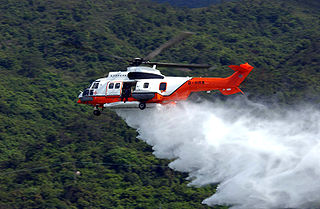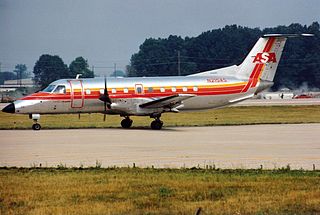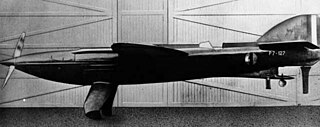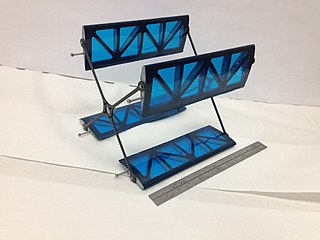
A propeller is a type of fan that transmits power by converting rotational motion into thrust. A pressure difference is produced between the forward and rear surfaces of the airfoil-shaped blades, and a fluid is accelerated by the pressure difference. Propeller dynamics, like those of aircraft wings, can be modelled by Bernoulli's principle and Newton's third law. Most marine propellers are screw propellers with helical blades rotating around an approximately horizontal axis or propeller shaft.

A drive shaft, driveshaft, driving shaft, tailshaft, propeller shaft, or Cardan shaft is a mechanical component for transmitting torque and rotation, usually used to connect other components of a drive train that cannot be connected directly because of distance or the need to allow for relative movement between them.
A variable-pitch propeller or controllable-pitch propeller (CPP) is a type of propeller with blades that can be rotated around their long axis to change the blade pitch. Reversible propellers—those where the pitch can be set to negative values—can also create reverse thrust for braking or going backwards without the need to change the direction of shaft revolution.

Hamilton Standard, an aircraft propeller parts supplier, was formed in 1929 when United Aircraft and Transport Corporation consolidated Hamilton Aero Manufacturing and Standard Steel Propeller into the Hamilton Standard Propeller Corporation. Other members of United Aircraft included Boeing, United Airlines, Sikorsky, and Pratt & Whitney. At the time, Hamilton was the largest manufacturer of aircraft propellers in the world.
Blade pitch or simply pitch refers to turning the angle of attack of the blades of a propeller or helicopter rotor into or out of the wind to control the production or absorption of power. Wind turbines use this to adjust the rotation speed and the generated power. A propeller of a ship uses this effect to control the ship's speed without changing the rotation of the shaft and to increase the efficiency of streaming fluids.
Feathers are epidermal growths which form an outer covering on birds and some dinosaurs.

The bamboo-copter, also known as the bamboo dragonfly or Chinese top, is a toy helicopter rotor that flies up when its shaft is rapidly spun. This helicopter-like top originated in Warring States period China around 400 BC, and was the object of early experiments by English engineer George Cayley, the inventor of modern aeronautics.

A rotorcraft or rotary-wing aircraft is a heavier-than-air flying machine that uses lift generated by wings, called rotary wings or rotor blades, that revolve around a mast. Several rotor blades mounted on a single mast are referred to as a rotor. The International Civil Aviation Organization (ICAO) defines a rotorcraft as "supported in flight by the reactions of the air on one or more rotors". Rotorcraft generally include those aircraft where one or more rotors are required to provide lift throughout the entire flight, such as helicopters, autogyros, and gyrodynes. Compound rotorcraft may also include additional thrust engines or propellers and static lifting surfaces.

Trans-Canada Air Lines Flight 304 was operated by a Vickers Viscount 700 aircraft owned by Trans-Canada Air Lines. On July 9, 1956, the No. 4 propeller of the aircraft tore loose from its engine over Flat Rock, Michigan in the United States, during a flight from Chicago, Illinois, to Toronto, Ontario, and Montreal, Quebec; one blade of the propeller sliced through the passenger section of the cabin, killing one passenger and injuring four passengers and one flight attendant. The aircraft diverted to Windsor, Ontario, in Canada, and the pilots carried out an emergency landing. The accident was the first to involve a Vickers Viscount aircraft in scheduled service, and was the first instance of a propeller loss on a turbo-prop aircraft.

In aeronautics, a propeller, also called an airscrew, converts rotary motion from an engine or other power source into a swirling slipstream which pushes the propeller forwards or backwards. It comprises a rotating power-driven hub, to which are attached several radial airfoil-section blades such that the whole assembly rotates about a longitudinal axis. The blade pitch may be fixed, manually variable to a few set positions, or of the automatically-variable "constant-speed" type.

The McCulloch J-2 was a small, two-seat autogyro with an enclosed cabin, one of only three designs of this type of aircraft to receive a type certificate in the United States. It was built by McCulloch Aircraft Corporation.

Atlantic Southeast Airlines Flight 2311 was a regularly scheduled commuter flight from Hartsfield–Jackson Atlanta International Airport to Glynco Jetport in Brunswick, Georgia on April 5, 1991. The flight, operated using a twin-turboprop Embraer EMB 120 Brasilia, crashed just north of Brunswick while approaching the airport for landing. All 23 people aboard the plane were killed, including passengers Sonny Carter and John Tower. Four years later, another Embraer Brasilia of ASA crashed in the Georgia countryside in similar circumstances, with nine fatalities.

A propeller governor senses the speed of an aircraft engine and changes the propeller blade angle to maintain a selected RPM regardless of the operational conditions of the aircraft.

The woldo, was a Korean pole weapon that closely resembled the Chinese guandao, though proportionally smaller. It was so named because of its curved blade. Its use and its methods were described in the Muyedobotongji, which was published in 1795.

A folding propeller is a type of propeller whose blades automatically fold out when the engine is turning, and then fold back when the engine stops. Folding propellers are found on sailing yachts, on model airplanes, and increasingly on self-launching gliders and small motor gliders, such as the Aériane Swift PAS. Their purpose of folding propellers is to reduce drag when sailing or soaring, respectively.

The Piaggio P.7, also known as the Piaggio-Pegna P.c.7, was an Italian racing seaplane designed and built by Piaggio for the 1929 Schneider Trophy race.
The Avian 2/180 Gyroplane was a two-seat, single engine autogyro built in Canada in the 1960s. Several prototypes were built but production was not achieved.

Hartzell Propeller was founded in 1917 by Robert N. Hartzell as the Hartzell Walnut Propeller Company. It is an American manufacturer of composite and aluminum propellers for certified, homebuilt and ultralight aircraft. The company headquarters is located in Piqua, Ohio.

The drivetrain of a motor vehicle is the group of components that deliver power to the driving wheels. This excludes the engine or motor that generates the power. In contrast, the powertrain is considered to include both the engine or motor and the drivetrain.

A cyclorotor, cycloidal rotor, cycloidal propeller or cyclogiro, is a fluid propulsion device that converts shaft power into the acceleration of a fluid using a rotating axis perpendicular to the direction of fluid motion. It uses several blades with a spanwise axis parallel to the axis of rotation and perpendicular to the direction of fluid motion. These blades are cyclically pitched twice per revolution to produce force in any direction normal to the axis of rotation. Cyclorotors are used for propulsion, lift, and control on air and water vehicles. An aircraft using cyclorotors as the primary source of lift, propulsion, and control is known as a cyclogyro. The patented application, used on ships with particular actuation mechanisms both mechanical or hydraulic, are named after the name of the German company that produces them: Voith–Schneider cycloidal propellers.


















